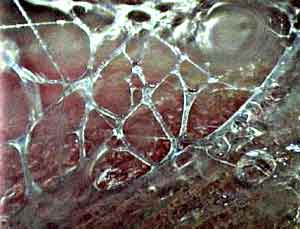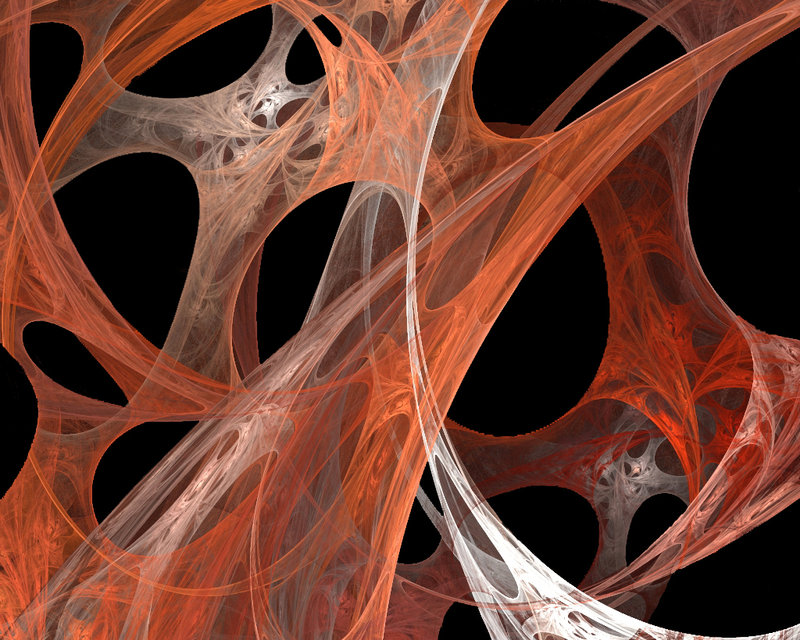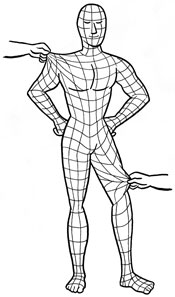What is Fascia?
 Scientific research of the last thirty years has only begun to illuminate the mystery of the fascia system. Western medicine considers fascia to be little more than sheets or bands of fibrous connective tissue. It's knowledge of human anatomy is directly derived from the dissection of human cadavers. That is to say, dead bodies. Dead bodies are, well, dead--without life, without consciousness, without energy. In this condition, it is easy to jump to the conclusion that fascia is not all that important.
Scientific research of the last thirty years has only begun to illuminate the mystery of the fascia system. Western medicine considers fascia to be little more than sheets or bands of fibrous connective tissue. It's knowledge of human anatomy is directly derived from the dissection of human cadavers. That is to say, dead bodies. Dead bodies are, well, dead--without life, without consciousness, without energy. In this condition, it is easy to jump to the conclusion that fascia is not all that important.
For centuries, the medical community has discounted fascia as just a superficial connective tissue of little to no significance in terms of health. What is taught in medical school today differs from this very little. However, thanks to recent scientific discovery, we now know that fascia is no more superficial than it is insignificant. On the contrary, fascia is our internal environment--it holds all of our cells and provides them what they need to function.
When our fascial system is troubled, it affects our entire existence: Our attitude, our energy, our health, our mobility. Restricted fascia reduces or stops cellular respiration--the flow of nutrients to and waste away from our cells. Respiration is essential to cellular function. If our cells can't function properly, they can become ineffective or even die. When ineffective, they can behave improperly or even mutate. Doctors call this disease. They classify disease according to symptoms . . . generally without considering the cause. They prescribe medications to restore proper cellular function or perform surgery to remove those that have stopped functioning or mutated. However, they never consider our internal environment--our fascial system.
Numerous research studies have proven the importance of healthy fascia, but that knowledge hasn't filtered into medical schools, hospitals, and doctor's offices yet. They simply cannot explain why their approach has failed you. In some cases, doctors have even blamed their patients' minds--calling them crazy--and referred them to a psychiatrist when they can't "find" anything to justify the patient's pain or dysfunction. As wrong as this sounds, those doctors are only half wrong: The patients weren't crazy, but it was in their mind! That is because our fascial system is the basis of the Body-Mind complex.
Among the many amazing discoveries about fascia is its role in intercellular communication--in controlling cellular function. This includes cellular respiration, muscle contraction, capillary dilation, etc. Our bodies are composed of billions of cells. Our nerves only contact a portion of them. How then, do the cells that have no direct contact with our nervous system receive commands to function? The answer is the fascia.
Thanks to advances in microscopic imagery technology, we now have a greater understanding of the structure of fascia and its various components. That has allowed us a better understanding of its functions--to include the transmission of electrical signals at speeds faster than nerve tissue is capable of. If fascia is restricted, these signals cannot get through to the cells waiting for commands. Additionally, recent research has shown that the majority of our nerve endings occur within the fascial Extracellular Matrix itself. This further confirms the fascial system's role in the healthy function of our bodies.
Now we see the significance of fascial restrictions: Restricting the flow of electrical commands and nutrients to cells and waste away from them. Similarly, we can also see the significance of disregarding our fascia.

So exactly what IS fascia? Macroscopically, fascia is a connective tissue that occurs in sheets and bands, both independent within the body and incorporated into other tissues as well, that maintains the form and function of the human body. It is a matrix of tissue that surrounds and permeates every other tissue in the entire body. Every type of tissue you can identify in the body--bone, muscle, skin, nerve, artery or vein--exists within the confines of the fascia . . . or is simply a different presentation of fascia. Microscopically, fascia forms the Extracellular Matrix that surrounds and supports all of our cells. This is the comprehensive nature of fascia. The fascia then can be considered the vessel which contains our body and maintains its form and function--our internal environment.
Fascial tissue is made up of three primary components: Collagen, Elastin, and Ground Substance. The collagen is a tough, rigid, structure that resembles small hollow tubes. These collagenous "microtubules" are assembled into a fractal matrix that both protects and supports all other tissue and transmits force effortlessly throughout the body. It is kind of like the steel girders of soft tissue. The elastin is, as the name implies, a soft and pliable tissue that stretches like a rubber band. The ground substance is an oil-like amino-alcohol; a liquid crystaline substance that exists both around and within the hollow collagen microtubules. It gives a hydraulic aspect to the fascia that assists in motion at the cellular level and prevents the microtubules from collapsing--thereby increasing their strength. It also acts as a lubricant to the external surfaces of the microtubules which allows reorganization of fascial structures under physical stress, otherwise referred to as "Fascial Glide."
The fascial matrix comprised of these three components is designed to be strong yet incredibly flexible. This is accomplished through the concept of tensegrity: Fascial structures are pre-loaded with tension allowing them to stretch or compress equally, freely, in multiple directions without losing strength. This is a concept that is distinctly non-linear. If follows, that, if the most basic and pervasive tissue of the human body is non-linear, must the same quality not also apply to the human body as a whole?
What does "matrix" mean? Webster's defines matrix as a form or container that may be "shaped like a pattern of lines and spaces." The fascial matrix is like a spider web--a structure that combines matter and space. It retains its shape when stretched or compressed--as a web would when a supporting branch sways in the wind. It also transmits stimuli throughout the matrix--like a web transmits to a waiting spider that a fly has flown into it. Also, as a web, the fascial matrix absorbs and dissipates shock waves. These are all nice capabilities of our body's foundational tissue. However, like a spider web, the fascial matrix is not infallible.
Fascia not only connects other tissues together, holding them in their place, it also maintains the form of the body. We know that muscles, tendons, and ligaments can be torn. Every day surgeries are performed to repair such tears. Yet, when such tears occur, our bodies maintain their form. It is the fascia that allows this to happen.

So we now know that fascia is a complex tissue that exists in a matrix throughout our entire body--connecting, protecting, and supporting all other tissues. This sounds pretty remarkable considering how specialized all other tissues in the body are. But what happens when this remarkable tissue fails to form according to design, or rather, loses its proper function?
When a physical trauma occurs, such as an extreme impact from a fall, an auto accident, or a well landed punch, the fascial matrix dissipates the shock/impact and carries it throughout the body. Wherever that shockwave stops (not just were the impact occurred) tissue can be damaged. At these locations of damage, fascial restrictions can occur. These restrictions occur, initially, as a means of protecting the injured tissue.
These intentional restrictions serve to isolate injured tissue from forces traveling through the body--whether walking, running, lifting, etc. They create new pathways to transmit force around these vulnerable areas. We see the result of these new pathways when we stand or move differently after an injury. We call these new protective postures and modified movements Compensatory Holding Patterns. They are essential to allowing us to function while we heal. However, if not properly addressed, they can last for years after the injured tissue has healed.
Over time, these protective "holding patterns" get reinforced. They become tight, sometimes extending beyond the original scope of the injury, and end up aggravating nerves, restricting our movement, shifting our structural balance, and impeding the flow of energy into areas of the body. As it is the fascia itself that is responsible for the holding pattern, typical soft tissue manipulation, such as massage, cannot affect the change required. To put this into perspective, consider this: Researchers have been able to measure the tensile strength of fascial restrictions to as high as 2,000 pounds per square inch. That is a level of force that one simply cannot "push through." Only MFR's static application of combined physical and energetic stimulus, sustained for enough time, in a relaxed state can facilitate a fascial release that lasts.
Fascia and Energy
Researchers have discovered something else fascinating about the fascia. It seems that it's capable of transmitting energy--electric signals--at speeds that far exceed the capability of our nervous system. In fact, fascia is now referred to as a "superconductor of energy," by quantum physicists. It has been claimed that the fascia is the most important form of communication in the body--solely responsible for the hundreds of thousands of actions each and every living cell in our body must take in order to survive . . . and thrive. This fascial system has also been labeled a "Liquid Crystal Matrix." This LCM surrounds every living cell of the body--sending them all the signals and energy needed to maintain healthy function. This is of paramount importance in terms of the physical body, but what of our energetic body?
It cannot be denied that we are energetic beings. Modern medicine uses equipment to measure the electric impulses traveling throughout the body. Psychiatrists and Sociologists acknowledge that people react to changes in gravitational/magnetic fields. Physicists assert we are affected by cosmic energy bombarding the planet. Statistics show significant changes in human behavior during full moons and cosmic events. Quantum physicists suggest that this erratic behavior would even be more prevalent were it not for our body's ability to filter out cosmic energy before it has the opportunity to affect our cells. So what is it that allows for this energy reception and filtration?
We all know that our nervous system transmits electric signals throughout the body. This is primarily for pain detection, sensory input, and motor response. Scientists have measured the energy transmission capacity of nerve tissue at about 20 meters per second. Quantum physicists have detected and documented cosmic energy pulses bombarding the earth at speeds faster than the speed of light. These energy pulses would easily overwhelm our nervous system if it were our body's only mechanism for addressing energy. Were this the case, we'd all be balled up in a fetal position unable to move and in immense pain every time such a pulse made it through our atmosphere. And yes, these pulses are even enough to overwhelm and pass through our ionosphere.
So we're left with the body's superconductor--the liquid crystaline matrix that is our fascial system. Quantum physicists suggest that it is the LCM that receives these energy pulses, slows them down, then dissipates and discards energy that would otherwise be harmful to us. That is not to say we may not be affected during these moments, but we survive thanks to our fascia. This is akin to a capacitor designed to absorb energy to protect electrical systems from an Electro Magnetic Pulse.
So what about our ability to flow and manipulate energy? There are numerous healing arts out there that acknowledge, and are based solely on, our ability to flow and manipulate energy both within and beyond our body. Acupuncture, Jin Shin Do, and Reiki are just a few of these. Whether it's a system based on energy meridians or energy fields, the bottom line is the same: Our bodies thrive thanks to the flow of energy. But this flow of energy goes far beyond the limits of our nervous system. How else can points on the arms or legs affect internal organs? How else can we send energy to another person? Then there's Kirlian photography that shows us the energy field extending beyond the tissue of the human body.

The only answer that makes sense given our current scientific and mathematical knowledge is the fascia. This liquid crystaline matrix is primarily responsible for the flow of energy and the transmission of communication signals within the body. Its nature as a superconductor certainly supports this, as does its prevalence throughout the body. So how is this affected by fascial restrictions?
Fascial restrictions well . . . restrict . . . both the tensegrital and gliding movements of the fascia and the flow of ground substance within the collagenous microtubules. While intimately connected, the two are separate events with their own set of problems associated. When the fascia is no longer able to flex, compress, or glide as it was designed to do, we experience reduced range of motion and often pain when we try to move. When the liquid crystaline ground substance is unable to flow, it solidifies, forming a hard crystal that, in this case, doesn't transmit energetic signals as quickly if at all. This is why we are so significantly affected by fascial restrictions--in terms of physical mobility, pain, and emotional/energetic well being.
When fascial restrictions are left unaddressed, entire areas of the body can be deprived of the energetic and nutritional nourishment that the fascia provides. This lack of nourishment affects cellular function and can lead to severe illness, even disease.
Expanding this idea further, if proteins can be described as chains of amino acids, and ground substance is an amino-alcohol, then it follows that solidified ground substance could likely resemble the structure of a protein. As the presence of "rogue proteins" has been linked to the formation of numerous cancers and other diseases, is it not reasonable to associate any number of identified and categorized illnesses (cancers) with long-term fascial restrictions deep in the body?
Recent research has confirmed that healthy fascia can facilitate recovery from disease, even cancer. By resolving fascial restriction(s) with MFR, proper cellular function can be restored and the progression of illness slowed, stopped completely, or even reversed. After all, Western Medicine diagnoses illnesses according to symptoms and most treatments are focused on abating those symptoms, not eliminating the root cause. If the cause of the symptoms is eliminated, so too are the symptoms. While this is not to say that all disease and illness is caused by fascial restrictions and can therefore be resolved with MFR, in many cases, this may in fact be true. For that reason alone, we all owe it to ourselves to receive MFR at least periodically to help facilitate and maintain our optimal health.
Fascia Resources
Fascia Research Published in Q1 2020: https://www.bodyworkmovementtherapies.com/article/S1360-8592(20)30061-9/fulltext?dgcid=raven_jbs_aip_email
Fascia: Clinical Applications for Health and Human Performance by Chad Robertson and Mark Lindsay; Delmar, 2008. http://www.barnesandnoble.com/w/fascia-mark-lindsay/1101415236?cm_mmc=googlepla-_-textbook_instock_75up_pt99-_-q000000633-_-9781418055691&cm_mmca2=pla&ean=9781418055691&isbn=9781418055691&r=1
Complimentary Therapies in Rehabilitation by Carol M. Davis; Slack Incorporated, 2009. http://books.google.com/books?id=s6fwPPJjXT4C&pg=PA47&lpg=PA47&dq=speed+of+energy+transmission+of+fascia&source=bl&ots=_kmvcbw_Ly&sig=DKgM3qSNBq62kuiSnsEDr2kd48E&hl=en&sa=X&ei=4FlVUpzlHbfH4AOKw4CADQ&ved=0CGcQ6AEwCQ#v=onepage&q=speed%20of%20energy%20transmission%20of%20fascia&f=false
Resources for Fascia Study: https://fasciaresearchsociety.org/resources
Myofascial Release Perspective: Therapeutic Insight--Fascia, a Liquid-Crystaline Matrix by John Barnes, PT; Massage Magazine. http://www.massagemag.com/News/print-this.php?id=7473
International Fascia Research Congress http://www.fasciacongress.org/
John Barnes Recommended Reading List http://myofascialrelease.com/resources/recommended-reading.aspx
